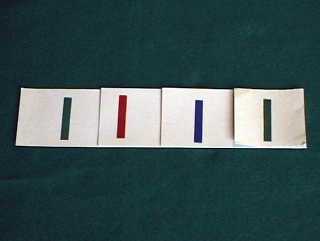Numeration of the Decimal System
Introduction to the Large Number Cards
When we wish to read a large number, for example "17264539",
we divide it into groups of hundreds, tens, and units by marking
every third place from the right, such as "17,264,539." This
makes it easy to read.
|
millions
H T U
1 7,
|
thousands
H T U
2 6 4,
|
simple
H T U
5 3 9
|
"Seventeen million, two hundred sixty four thousand,
five hundred thirty nine."
MATERIAL:
- Large number cards
- The units (1 to 9) are printed in green on white card.
- The tens (10 to 90) are printed in blue on white card.
- The hundreds (100 to 900) are printed in red on white card.
- The units of thousands (1000 to 9000) are printed in green on
white card.
- The ten cards are twice the width of the unit cards. The
hundred cards are three times the width of the unit cards. The
thousand cards are four times the width of the unit cards.
Exercise 1
 MATERIAL:
MATERIAL:
- The large number cards, 1, 10, 100, 1000, as described in the
previous paragraph.
PREREQUISITE:
- The child needs to be able to identify any quantity up to 9999.
AGE:
- 4 to 5 years
EXERCISE:
First Period
-
- The teacher will introduce the way we write the numbers "100,"
and "1000," along with "1," and "10," through a three period lesson
similar to the lesson introducing the quantities "100," and "1000." The
teacher takes the numeral cards for 1, 10, 100, and 1000 to a table.
She places the numerals to her side. The teacher shows the unit card to
the child. He can tell her that is "one." She removes it to her side
and next shows him the "ten" card and lets him tell her what it is.
-
- She removes it and then shows him the "100" card and tells him,
"This is how we write one hundred." She then places it to her
side and shows the child the "1000" card and says, "This is how we
write one thousand."

Second Period
- Using all four cards, the teacher proceeds with the remainder of
the three period lesson. The teacher places the cards in random
order in front of the child. "Point to one hundred....Which one
is one thousand? Show me ten....Point to one." This period is
repeated with the teacher occasionally changing the order of the
figures.

- When the child is not making any mistakes, the teacher proceeds
to the third period.
Third Period
- The number cards are placed at the side of the table, out of
child's direct view. The teacher places one of the number cards
in front of the child and asks him to tell her the name. "Which
one is this?" The child gives the name. The teacher removes
that number card to the side of the table and continues in the same
manner with the other number cards.

SUMMARY:
- At the end of the lesson the teacher removes all the cards to her
side. She then summarizes as follows in one continuous motion.
-
- She places out the "1000" and says, "Today you learned that this
is how we write one thousand..."
-
- (she then places the "100" on top of the "1000") "...one
hundred..."
-
- (she then places the "10" on top of the "100" in the tens place)
"...ten..."
-
- (she then places the "1" on top of the "10" in the units place)
"...one."
-
- Then, the teacher reads the number again pointing to the values.
-
- "One thousand, one hundred, one ten, one."
-
-

MATERIAL: